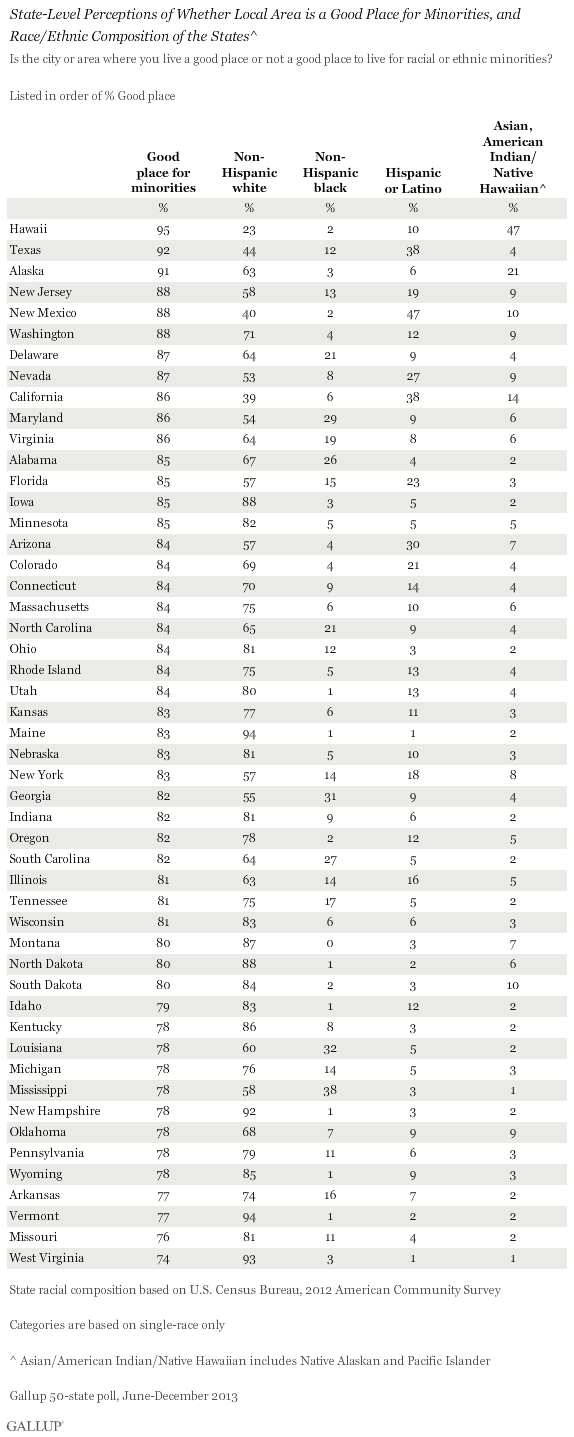Gallup's major 50-state poll conducted in 2013 included a question asking residents of each state to rate the city or area where they live as "a good place to live for racial or ethnic minorities." My colleague Lydia Saad analyzed the resulting data in some detail a few months ago, pointing out that residents of all states in the union were, in general, positive about the climate in their area for racial minorities, but highlighting the significant differences across states. Hawaii's residents were the most positive, with 95% of residents of Hawaii rating their area as a good place for race and ethnic minorities, followed by 92% of residents of Texas and 91% of residents of Alaska. The 50-state average on this measure is 83%. (The list, along with the minority population of each state, is available below.)
At the bottom of the list was West Virginia, where 74% of residents rated their city or area as a good place for racial and ethnic minorities to live. That's still positive on an absolute basis, of course, but on a relative basis a full 21 percentage points lower than the rating given by residents in Hawaii.
Importantly, residents of Missouri were 49th out of 50 states on this racial climate measure. Overall, 76% of Missouri residents said that their area was a good place for racial and ethnic minorities, while 22% said it was not. As noted, the only state lower on this measure was West Virginia.
Obviously, all of this is relative. Even at the bottom of the list, about three-quarters of residents of West Virginia and Missouri were positive about the climate for minorities in their area. Still, Missouri residents were next-to-last on the list.
The question is how germane this is to the current situation in Ferguson, Missouri, the town in which 18-year-old African-American Michael Brown was shot to death by a white policeman. There have been protests and riots and violence in Ferguson in the days and weeks following the shooting.
Ferguson has a population of about 21,000 people, a fraction of Missouri's overall population of 6 million -- giving Ferguson about one-third of one percent of the state's population. But Ferguson is part of the St. Louis Metropolitan Statistical Area, which is by far the biggest region of the state, comprising just under half of the state's population. So when a relatively low percentage of residents across the entire state interviewed in our poll say that the area or city where they live is a good place to live for racial minorities, a lot of those residents are talking about the St. Louis area.
As noted, we can't break out data on Ferguson per se. So we don't know how residents of that town would answer the questions about their area being a good place to live for racial minorities. But the fact that, across the state, residents of Missouri are so low on that measure (on a relative basis) gives us pause. It raises the possibility that the strong and sometimes violent reaction to the shooting in Ferguson may, to some degree, be symptomatic of a race situation in the region that has more negative components to it that the situation across the country.
Lydia Saad's analysis showed that the relationship between the racial composition of a state and its residents' ratings of the racial climate is by no means straightforward. The relationship does appear to be quite clear in Hawaii, which has only 23% white residents -- with Asians being by far the highest race segment. But having high percentages of black residents doesn't in and of itself lead to either negative or positive views of the place being good for minorities. Delaware has 21% black residents, well above the national average, and is in the top 10 states in terms of their residents saying it is a good place for minorities to live. Maryland, Virginia, and Alabama also have black populations that are way above the national average (on a percentage basis), and are in the top 12 states in terms of residents saying their area is good place for minorities to live. On the other hand, Arkansas, Mississippi and Louisiana also have above average black percentages (Mississippi has the highest percentage black population in the nation), yet their state ratings on having a good climate for racial and ethnic minorities are near the bottom.
As a state, Missouri has 11% black residents, roughly at the national average. Ferguson, of course, is a distinct and tiny part of Missouri. It's population consists of about two-thirds black residents. But extrapolating from the 50-state data, Ferguson's having a large black population doesn't in and of itself suggest a necessarily negative environment for minorities.
So, what we know is that Ferguson is part of a state whose residents are quite negative when asked if their cities and areas are good places for minorities to live. The extent to which this relatively negative climate is a factor in the reaction to the Ferguson situation is not quantifiable. Ferguson has a distinct and idiosyncratic history, with a rapid turnover from a predominantly white to predominantly black suburb in recent decades, and a police force whose racial composition does not mirror that of the city's population. Still, the fact that Ferguson is in a state whose residents perceive a relatively less positive climate for minorities is certainly of note.

